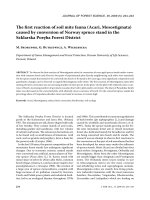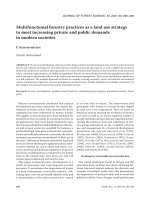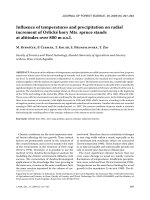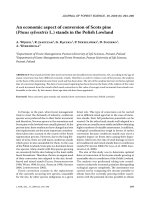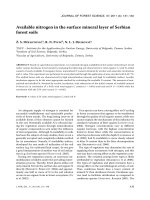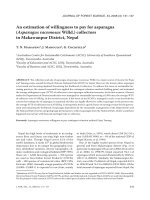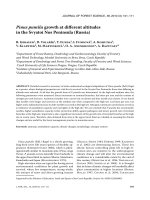Báo cáo lâm nghiệp: " An for attempt at generating haploid lines of Poplar species genetic manipulation and breeding program" pptx
Bạn đang xem bản rút gọn của tài liệu. Xem và tải ngay bản đầy đủ của tài liệu tại đây (164.99 KB, 3 trang )
An
attempt
at
generating
haploid
lines
of
Poplar
species
for
genetic
manipulation
and
breeding
programs
K.E.
Wolter
B.H.
McCown
Department
of
Horticulture,
University
of
Wisconsin,
Madison,
WI
53706,
U.S.A.
Introduction
The
successful
establishment
of
haploid-
derived
strains
in
herbaceous
crop
plants
has
proven
that
this
procedure
is
both
viable
and
extremely
desirable.
For
example,
over
80
new
rice
varieties
have
been
established
via
this
procedure
(Siva
Reddy
et
a/.,
1985)
and
20
000
ha
of
new
tobacco
varieties
have
been
planted
(Hu
et
al.,
1978).
Production
and
use
of
haploids
for
tree
breeding
and
biotechno-
logical
manipulation
can
be
equally
pro-
ductive,
yet
only
a
relatively
few
attempts
have
been
made
to
establish
these
lines
(Wang
et al.,
1975;
Chen
et al.,
1979;
Zhu
et al.,
1980;
Karnosky
et al.,
1981;
Ho
and
Raj
1985;
Hyun
et
aL,
1986;
and,
for
oak
and
horsechestnut,
Jorgensen,
personal
communication).
The
use
of
haploids
has
special
significance
for
genetic
improve-
ment
in
forest
trees
and
other
woody
spe-
cies
where
traditional
breeding
procedures
and
genetic
manipulation
are
more
difficult
owing
to:
1)
long
generation
times
typical
of
many
tree
species;
2)
high
heterozygo-
sity;
3)
factors,
such
as
parthenocarpy
and
self
incompatibility,
which
are
common;
and
4)
poor
embryo
viability
which
often
occurs.
The
main
objective
is,
therefore,
to
establish
haploid
cell
lines
of
selected
Poplar
clones
from
anthers
which
will
then
be
regenerated
into
shoots
and
roots
for
further
manipulation
via
microculture
procedures.
Additional
use
of
these
tis-
sues
in
protoplast
fusion
work
will
enable
construction
of
new
forest
trees.
Materials
and
Methods
Poplar
species
were
chosen
as
a
model
for
the
following
reasons:
1)
an
extensive
record
of
clonal
lines
exists
with
growth
patterns
and
characteristics
known
for
such
genotypes;
2)
availability
of
these
clones
as
mature
breed-
ing
stock;
3)
some
knowledge
of
poplar
chromosome
morphology;
4)
viable
procedures
for
poplar
organogenesis
and
regeneration
(Wolter,
1968;
Russel
and
McCown,
1988);
5)
transcription
of
desirable
genes
into
poplar
and
increased
recovery
of
transformed
poplar
shoots
(Fillatti et al.,
1987).
Attempts
to
obtain
haploid
tissues
were
made
from
the
following
clones:
1)
Eugenei
(NC
5326,
P.
deltoides
x
R
nigra);
2)
Androscoggin
(NC11390,
P.
maximowiczii
x
P.
trichocarpa);
3)
Crandon
(NC
5339)
P.
alba
x
R
grandiden-
tata;
4)
Wisconsin
wild
selection
(Wis.
W-5).
Catkins
isolated
during
dormancy
were
stored
at
-18°C
(for
a
maximum
of
3
mo),
sterilized
and
allowed
to
elongate
under
ambient
condi-
tions.
The
scheme
of
Bajaj
(1983}
was
followed
with
attempts
at
both
pollen
and
anther
cultures.
Isolates
were
placed
on
different
media
(Wolter
and
Skoog,
1966;
Lloyd
and
McCown,
1980)
to
initiate
viable
cultures
as
well
as
differentiation
medium
(Russel
and
McCown,
1986).
Ploidy
levels
were
monitored
microscopically
using
a
modified
8-hydroxy-
quinone/acetocarmine
procedure
of
Somego
(1978).
Results
Successful
viable
isolates
were
establish-
ed
for
all
tested
Poplar
clones
from
anther
microspores
on
the
2,4-D
(2,4-dichloro-
phenoxy-acetic
acid;
0.04
mg/I)
medium
of
Wolter
and
Skoog
{1966).
Root
differentia-
tion
was
rapidly
established
for
Eugenei
with
NAA
(naphthalene
acetic
acid;
2
mg/1);
shoot
organogenesis
was
not
achieved
with
this
clone,
though
numer-
ous
levels
of
cytokinins
were
tested.
The
Crandon
isolates
were
viable
and
callus
cultures
were
established,
but
organ
dif-
ferentiation
was
not
obtained.
Wisconsin
W-5
was
the
most
amenable
for
the
production
of
shoots
on
a
medium
sup-
plemented
with
0.01
pM
N-phenyl-N-1,2,3-
thiadiazol-5-ylurea
(thiodiazuron).
In
all
cases
of
successful
shoot
differentiation,
ploidy
levels
were
diploid.
To
date,
dif-
ferentiated
roots
have
not
been
analyzed.
Analysis
of
ploidy
levels
has
been
the
largest
technical
problem
of
the
investiga-
tion.
Poplar
species
have
the
smallest
amount
of
DNA
of
most
tree
species
(7
pg/cell)
thereby
making
monitoring
extremely
difficult.
Discussion
and
Conclusion
The
conclusions
from
the
results
obtained
to
date
are
that
production
and
mainte-
nance
of
haploid
tissue
lines
requires
constant
monitoring
for
ploidy
levels.
A
rapid
establishment
of
stable
cultures
(preferably
shoot
microculture)
so as
to
avoid
increasing
ploidy
levels
through
un-
stable
callus
subcultures
is
essential.
If
these
objectives
are
maintained
and
ha-
ploid
material
is
stabilized,
the
manipula-
tions
enumerated
in
Table
I are
possible
(Bonga
et
al.,
1987).
References
Bajaj
Y.P.S.
(1983)
In
vitro
production
of
haploids.
In:
Handbook
of
Plant
Cell
Culture.
Vol.
I.
(Evans
D.A.,
Sharp
W.R.,
Ammirato
P.V.
&
Yamada
Y,
eds.),
MacMillan,
New
York,
pp.
228-287
Bonga
J.M.,
Von
Aderkas
P.
&
James
D.
(1988)
Potential
application
of
haploid
cultures
of
tree
species.
In:
Genetic
Manipulation
of
Woody
Plants.
(Hanover
J.W.
&
Keathley
D.E.,
eds.),
Plenum
Press,
New
York,
pp.
57-58
Chen
Z.,
Chen
F.,
Qian
C.,
Wang
C.,
Zhang
S.,
Xu
X.,
Ou
X.,
He
Y
&
Lu
Z.
(1979)
A
process
of
obtaining
pollen
grain
plants
from
Hevea
brasiliensis
Muell.
Arg.
Sci.
Sin.
22,
81-90
Fillatti
J.J.,
Sellmer
J.C.,
McCown
B.H.,
Hassig
B.
&
Comai
L.
(1987)
Agrobacterium-mediated
transformation
and
regeneration
of
Poplar.
Mol.
Gen.
Genet.
206, 192-199
Ho
R.H.
&
Raj
Y
(1985)
Haploid
plant
produc-
tion
through
anther
culture
in
Poplar.
For.
Ecol.
Manage.
13, 133-142
Hu
H.,
Hsi
T.Y.,
Tseng
C.C.,
Ouyang
T.W.
&
Ching
C.K.
(1978)
Application
of
anther
cultures
to
crop
plants.
In:
Frontiers
of
Plant
Tissue
Culture.
(Thorpe
T.A.,
ed.),
Proc.
4th
Interna-
tional
Assoc.
of
Plant
Tissue
Culture.
Univ.
of
Calgary,
Canada.
pp.
123-130
Hyun
S.K.,
Kim
J.H.,
Noh
E.W.
&
Park
J.1.
(1986)
Induction
of
haploid
plants
of
Populus
species.
In:
Plant
Tissue
Culture
and
its
Appli-
cations.
(Withus
L.A.
&
Alderson
P.G.,
eds.),
Butterworth,
London,
pp.
413-416
6
Karnosky
D.F.
(1981)
Potential
for
forest
tree
improvement
via
tissue
culture.
Bioscience
31,
114-119
Lloyd
G.
&
McCown
B.H.
(1980)
Commercially-
feasible
micropropagation
of
mountain
laurel,
Kalmia
latifolia,
by
use
of
tip
shoot
cultures.
In:
Proc.
Int.
Plant
Propagators
Soc.
30,
421-427
Russell
J.E.
&
McCown
B.H.
(1986)
Culture
and
regeneration
of
Populus
leaf
protoplasts
iso-
lated
from
non-seedling
tissue.
Plant
Sci.
46,
133-142
Russell
J.E.
&
McCown
B.H.
(1988)
Recovery
of
plants
from
leaf
protoplasts
of
hybrid
poplar
and
aspen
clones.
Plant
Sci.
Rep.
7,
59-62
Siva
Reddy
V.,
Leelavathi
S.
&
Sen
S.K.
(1985)
Influence
of
genotype
and
culture
medium
on
microspore
callus
induction
and
green
plant
regeneration
in
anthers
of
Oryza
sativa.
Phy-
siol.
Plant. 63,
309-314
4
Somego
M.
(1978)
Cytogenetical
studies
of
the
Dipterocarpaceae.
Malay.
For.
41,
358-365
Wang
C.C.,
Chui
Z.C.
&
Sun
C.S.
(1975)
The
induction
of
poplar
pollen
plants.
Acta
Bot.
Sin.
17, 56-59
Wolter
K.E.
(1968)
Root
and
shoot
initiation
in
aspen
callus
cultures.
Nature 219,
509-510
0
Wolter
K.E.
&
Skoog
F.
(1966)
Nutritional
re-
quirements
of
Fiaxinus
callus
cultures.
Am.
J.
Bot.
41,
272-280
Zhu
X.X.,
Wang
R.L.
&
Liang
Y.L.
(1980)
Induc-
tion
of
poplar
pollen
plantlets.
Sci.
Silvae
Sin.
16, 190-197

